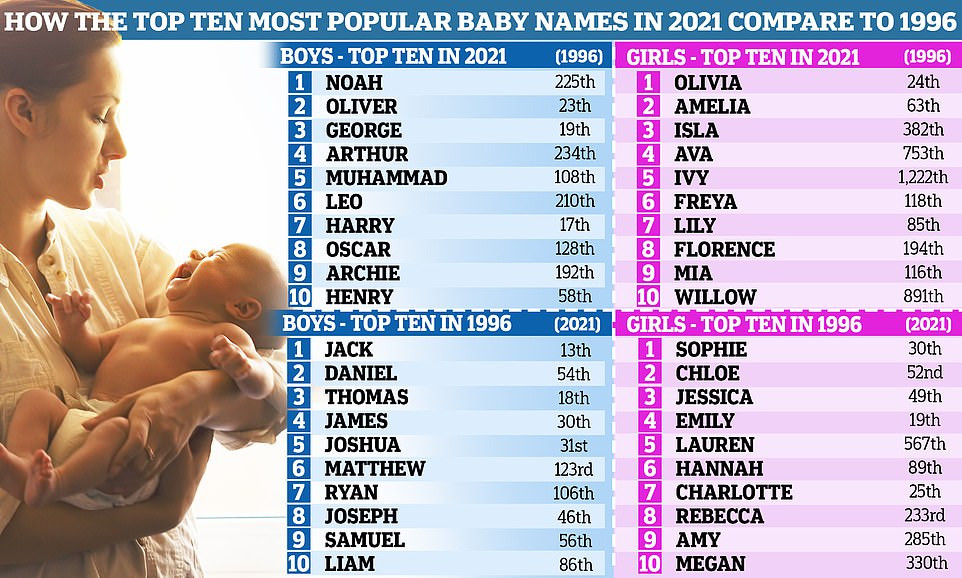A Journey Through Baby Name Trends: From Classic Marys to Modern Olivias
The analysis broke down the naming data by Gen Alpha, Gen Z, Millennials, and Gen X—and revealed some surprising trends. It’s almost impossible to understate how popular the name Mary once was in the United States. For starters, it was ranked first in the U.S. for girls’ births registered with the Social Security Administration almost every year from the 1880s until 1961 (apart from a brief six-year period in the 1940s and ’50s when it was overtaken by Linda). And in the 100 years from 1924–2023, in total just shy of 3 million girls were recorded as being named Mary—almost as many as the second (Patricia) and third (Jennifer) most popular U.S. girls’ names added together.
But tastes change over time, and with one generation after another. By 1972, Mary was ranked a relatively low 13th overall (dropping out of the top 10 for the first time in SSA history), and its popularity has continued to decline ever since. In 2023, it came in at only 135th, placing it behind names like Ariana, Skylar, Raelynn, and Adalynn.
The Shifting Landscape of Baby Names: A Generational Analysis
Now, a new survey has sought to uncover some of the other remarkable trends and fashions that have shaped America’s most popular names, by charting the top baby names in every state for every generation from Gen X to Gen Alpha.
The analysis, compiled by language blog Wordtips, took the 100 most popular boys’ and girls’ names, state by state in the U.S., for each year since 1965 (using naming data recorded by the Social Security Administration). The data was then broken down across the last four generations: Gen Alpha (2013–2023), Gen Z or “Zoomers” (1997–2012), Millennials (1981–1996), and Generation X (1965–1980).
Gen Alpha: The Reign of Liam and Olivia
Beginning with the most recent data, the study found that Liam is the most popular boys’ name among Gen Alpha in 27 states (with its longer equivalent, William, taking the top slot in 10). In fact, Liam has been the U.S.’s most popular boys’ name every year since 2017.
Noah—currently America’s second most popular boy’s name—topped the Gen Alpha list in a handful of other states, including California, Texas, New Mexico, Illinois, and Hawaii. Among the remaining outliers were Wyatt (number one only in Wyoming), Henry (in Minnesota), and Oliver (in Vermont).
As for the girls, America’s current most popular girls’ name, Olivia—a position it too has held every year since 2019—topped the list in 27 states, among them New York, Washington, and Hawaii. Emma, America’s current number two overall, came out on top in the likes of Texas, California, and South Dakota, followed by Ava (in a swath of states in the southeast), Charlotte (in three New England states), and Sophia (in New Mexico and Nevada). Florida was the only state to record anything different on the girls’ list, with Isabella making it to number one there.
Gen Z: A Departure From the Traditional
When we move to Gen Zers, the map looks completely different, demonstrating just how much tastes have changed. Here, Jacob was the most popular boys’ name in 28 states, followed by William and Michael. As for the girls’ map, Emily and Madison topped the list in 20 states each, with the names Emma, Hannah, and Alyssa making up the remainder.
Millennials: Michael and Jessica Reign Supreme
The Millennials name map becomes far more homogenized, with Michael dominating the boys’ list in 38 states, and Jessica all but obliterating the competition for the girls and coming out on top in a staggering 42 out of 50 states. In fact, so all-encompassing were these two names among the Millennial generation that, as Wordtips points out, 3 percent of all boys born in 1982 alone were named Michael, while 2.3 percent were named Jessica. Among the handful of other names to be featured on the Millennial map are Christopher and Matthew (which appears in Maine alone) for the boys, and Ashley and Sarah (only in Vermont!) for the girls.
Gen X: A Mix of Classics and Newcomers
Lastly, the Gen X story is one of extremes. In the case of the boys, the penchant for naming babies Michael seems to have begun in the ’60s and ’70s, with Michael coming out on top among Gen X in every single U.S. state except for Mississippi and South Carolina (where James came out on top). The girls’ map, however, is far more mixed up: Although Jennifer was ranked first in 22 states, the remaining 28 show a medley of several different names, among them Maria, Angela, Kimberly, Melissa, and Lisa.
Names That Stand the Test of Time
Combining the data from all four maps allowed the analysts to look at how names have changed in popularity across the last four generations.
Remarkably, for boys, just one name made it into the top 10 for Gen Alpha, Gen Z, Millennials, and Generation X, with Michael ranked, from Gen Alpha to Gen X, ninth, second, first, and first again, respectively. Some early names from the Gen X and Millennial top 10s that have long since fallen out of the list include David (ranked second among Gen Xers) and Matthew (which was ranked third among Millennials, before falling to fourth among Zoomers, and eventually out of the top 10 all together). The current Gen Alpha top 10, meanwhile, includes several names that had never appeared in the top 10 of previous generations—including Ethan, Mason, Elijah, and the current number one, Liam.
As for the girls, the Gen Xers’ number one, Jennifer, tells a similar story to Michael, having fallen to fifth place among Millennials before dropping out of the top 10 altogether. The likes of Melissa (sixth among Gen X), Nicole (eighth among Millennials) and Madison (second among Gen Z), meanwhile, have only enjoyed one brief moment in the girls’ top 10. In fact, only one girls’ name has stood the test of generational time: Though it didn’t make it into the Gen Alpha list, Elizabeth nevertheless made the top 10 for all three previous generations, ranking seventh among Gen Z and Millennials, and eighth among Gen X.
What Does the Future Hold for Baby Names?
The current trends suggest that parents are gravitating towards unique and modern names, with classic names slowly fading into the background. However, some names, like Michael and Elizabeth, continue to hold a special place in American naming history. It will be interesting to see how these trends evolve in the coming years, and whether new names will emerge as the favorites of future generations.
The Final Word
From the enduring popularity of Michael to the rise of Liam and Olivia, the world of baby names is constantly changing. While some names fade into obscurity, others remain etched in American naming history. By analyzing the trends across generations, we gain a deeper understanding of the cultural forces that shape our society and the names we choose to give our children. These names are not just words, but they are reflections of our values, our aspirations, and our hopes for the future.

















